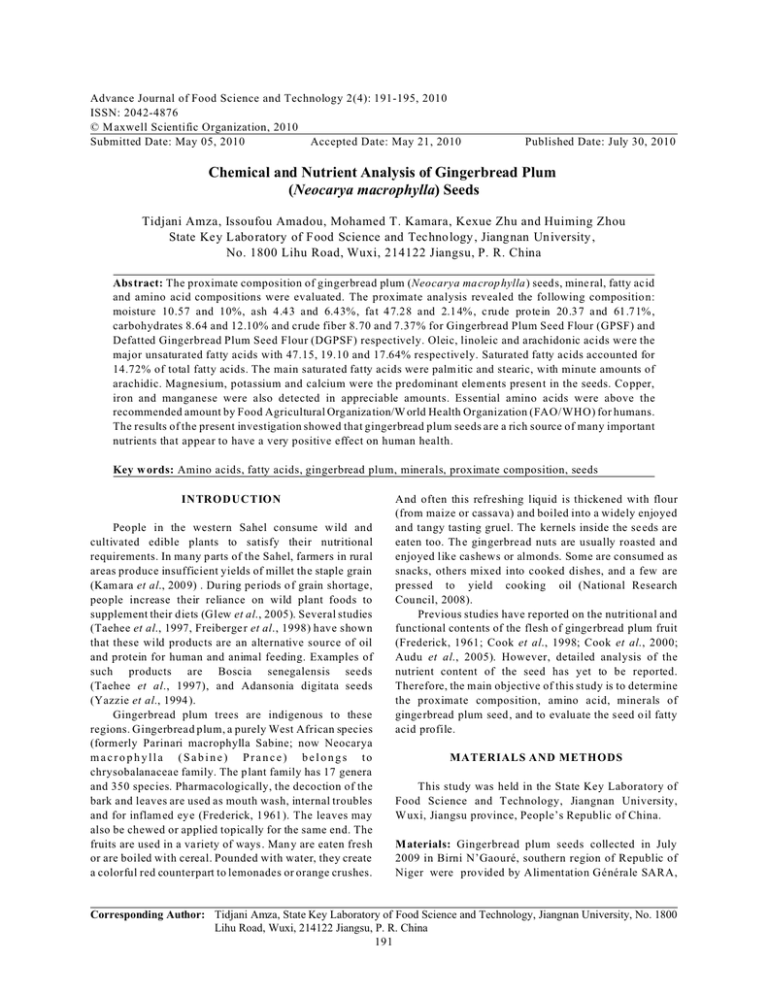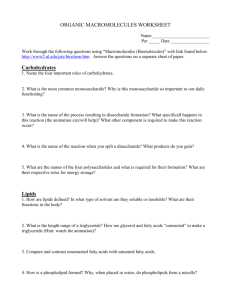Advance Journal of Food Science and Technology 2(4): 191-195, 2010
advertisement

Advance Journal of Food Science and Technology 2(4): 191-195, 2010 ISSN: 2042-4876 © M axwell Scientific Organization, 2010 Submitted Date: May 05, 2010 Accepted Date: May 21, 2010 Published Date: July 30, 2010 Chemical and Nutrient Analysis of Gingerbread Plum (Neocarya macrophylla) Seeds Tidjani Amza, Issoufou Amadou, Mohamed T. Kamara, Kexue Zhu and Huiming Zhou State Key Laboratory of Food Science and Techno logy , Jiangnan University , No. 1800 Lihu Road, Wuxi, 214122 Jiangsu, P. R. China Abstract: The proximate composition of gingerbread plum (Neocarya macrop hylla) seeds, mine ral, fatty acid and amino acid compositions were evaluated. The proximate analysis revealed the following composition: moisture 10.57 and 10%, ash 4.43 and 6.43%, fat 47.28 and 2.14%, crude protein 20.37 and 61.71%, carbohydrates 8.64 and 12.10% and crude fiber 8.70 and 7.37% for Gingerbread Plum Seed Flour (GPSF) and Defatted Gingerbread Plum Seed Flour (DGPSF) respectively. Oleic, linoleic and arachidonic acids were the major unsaturated fatty acids with 47.15, 19.10 and 17.64% respectively. Saturated fatty acids accounted for 14.72% of total fatty acids. The main saturated fatty acids were palm itic and stearic, with minute amounts of arachidic. Magnesium, potassium and calcium were the predominant elem ents present in the seeds. Co pper, iron and manganese were also detected in appreciable amounts. Essential amino acids were above the recommended amount by Food Agricultural Organization/W orld Health Organization (FAO/WHO) for humans. The results of the present investigation showed that gingerbread plum seeds are a rich source of many important nutrients that appear to have a very positive effect on human health. Key w ords: Amino acids, fatty acids, gingerbread plum, minerals, proximate composition, seeds INTRODUCTION People in the western Sahel consume wild and cultivated edible plants to satisfy their nutritional requirements. In many parts of the Sahel, farmers in rural areas produce insufficient yields of millet the staple grain (Kam ara et al., 2009) . Du ring pe riods of grain shortage, people increase their reliance on wild plant foods to supplement their diets (Glew et al., 2005). Several studies (Taehee et al., 1997, Freiberge r et al., 1998) have shown that these wild products are an alternative source of oil and protein for human and animal feeding. Examples of such products are Boscia senegalensis seeds (Taehee et al., 1997), and Adansonia digitata seeds (Yazzie et al., 1994 ). Gingerbread plum trees are indigenous to these regions. Gingerbread plum, a purely West African species (formerly Parinari macrophylla Sabine; now Neocarya m a c r o p h y l l a ( S a b i n e ) P r a n c e ) b e l o n g s to chrysobalanaceae family. The p lant family has 17 genera and 350 species. Pharmacologically, the decoction of the bark and leaves are used as mouth wash, internal troubles and for inflam ed ey e (Fred erick, 1961). The leaves may also be chewed or applied topically for the same end. The fruits are used in a va riety of ways. Man y are eaten fresh or are boiled with cereal. Pounded with water, they create a colorful red counterpart to lemonades or orange crushes. And often this refreshing liquid is thickened with flour (from maize or cassava) and boiled into a widely enjoyed and tangy tasting gruel. The kernels inside the se eds are eaten too. Th e gingerbread nuts are usually roasted and enjoyed like cashews or almonds. Some are consumed as snacks, others mixed into cooked dishes, and a few are pressed to yield cooking oil (National Research Council, 2008). Previous studies have reported on the nutritional and functional contents of the flesh of ginge rbread plum fruit (Frederick, 1961; Cook et al., 1998; Cook et al., 2000; Audu et al., 2005). However, detailed analysis of the nutrient content of the seed has yet to be reported. Therefore, the main objective of this study is to determine the proximate composition, amino acid, minerals of ginge rbread plum seed, and to evaluate the seed o il fatty acid profile. MATERIALS AND METHODS This study was held in the State Key Laboratory of Food Science and Technology, Jiangnan University, W uxi, Jiangsu province, People’s Republic of China. M aterials: Gingerbread plum seeds collected in July 2009 in Birni N’Gaouré, southern region of Republic of Niger were provided by Alimentation Générale SARA, Corresponding Author: Tidjani Amza, State Key Laboratory of Food Science and Technology, Jiangnan University, No. 1800 Lihu Road, Wuxi, 214122 Jiangsu, P. R. China 191 Adv. J. Food Sci. Technol., 2(4): 191-195, 2010 Tab le 1: Pro xim ate chemical comp osition of gingerbread plum seed flour (GPSF) and defatted gingerbread plum seed flour (DG PSF) (g/100 g, dry matter basis) C he mic al c om po sitio n (% ) GPSF DGPSF Moisture 10.57±0.98 10.00±1.00 Cru de p rotein 20.37±1.36 61.71±0.89 Cru de lip id 47.28±1.36 2.14±1.01 Ash 4.43±0.82 6.43±0.73 Carbohydrates 8.64±0.29 12.10±0.70 Crude fiber 8.70±1.01 7.37±0.93 Va lue s are me an s ±s tan da rd d ev iatio n o f thr ee d eter min atio ns. Niamey, Niger. The seeds were milled using a laboratory scale hammer miller and the resulting flour was sieved through a 60 mesh screen. The Gingerbread Plum Seed Flour (GPSF) was dispersed in hexane at flour to hexane ratio of 1:5 (w/v) and stirred for 4 h at room temperature. The experiment was repeated twice as described above. The hexane was decanted and the defatted gingerbread plum seed flour (DGPSF) was air dry for 24 h under a vacuum drier and stored at 5±1ºC in sealed glass jars until use. esters were identified by comparison with the retention times of NU CH ECK Inc. standards (Elysian, 1L) and quantified by internal normalization. M ethods: Proximate analysis: The proximate composition of GPSF and DGPSF was determined according to Ceirwyn (1995). The moisture content was determined by drying in an oven at 105±1ºC until a constant weight was obtained. Ash was determined by weighing the incinerated residue obtained at 525±1ºC after 4 h. Crude fat was extracted by the Soxhlet method with petroleum ether. The crude protein was determined by the micro-Kjeldahl method and a Conversion factor of 6.25 was used to quantify the crude protein content (Tkach uk, 1969 ) and crude fibre was determined by AOA C (1995). The carbohydrate content was estimated by subtracting the sum of percentage of moisture, crude fat, crude protein, fibre and ash contents from 100%. Triplicate samples were analyzed for each sample. Mineral analysis: The minerals were analyzed from solutions obtained by first dry ashing the DGPSF at 525±1ºC to obtain the ash. The residue of the sample was dissolved in 10 mL of 50% of nitric acid solution and made up to final volume of 25 mL of distilled water. After that the minerals (Zn, Fe, Cu, Mn, Na, K, Mg, and Ca) were analyzed separately, using an Atomic Absorption Spectrophotometer of Spectra AA 220, USA Varian. Phosphorus was analyzed by the phosphovanado moly bdate method of AOAC (1995). The data reported represent the average of three determinations. RESULTS AND DISCUSSION Proximate chemical composition: The moisture content of GPSF was similar to those of several legumes proteins (Alsmeyer et al., 1974; Akubor et al., 2004; Aremu et al., 2006 ) Table 1. Th e protein content from the sample was significantly increased after defatting (20.3761.71% ). The qu antity of crude protein was co mparable with crude proteins in protein-rich foods such as soybeans, cowpeas, pigeon pea and Kersting’s groundnut (Olaofe et al., 1994; Aremu et al., 2006). The ether extract (crude lipid) mean values were 47.28 and 2.14% for GPSF and DGPSF, respectively, Table 1. Our results were higher when compared with the values reported for two varieties of bambara groundnut 4.10 and 6.72% (Aremu et al., 2006), and pear millet and quino a (7.6 and 6.3% ), Oshodi et al. (1999) but were compa rable to C. vulgaris (47.7%), Meshach et al. (1984) and T. occidentalis (54.4), Olaofe et al. (1994). This is an indication that gingerbread plum seeds can be grouped as part of oil-rich legume seeds. The crude fibre was com parab le with most legumes such as pigeon pea, cowpea, coccineus and oil seeds (Olaofe et al., 1994). There is evidence that crude fibre has a number of beneficial effects related to its indigestibility in the small intestine (Aremu et al., 2006). Amino acid analysis: The dried samples were digested with HCl (6 M) at 110ºC for 24 h under nitrogen atmosphere. Rev ersed phase high perform ance liquid chromatography (RP-HP LC ) analysis was carried ou t in an Agilent 1100 (A gilent T echnologies, Palo Alto, CA, USA) assembly system after precolumn derivatization with O-phthaldialdehyde (OPA). E ach samp le (1 :L) was injected on a Zorbax 80 A C18 column (i.d., 4.6×180 mm, Agilent Technologies, Palo Alto, CA, USA) at 40 o C w ith detection at 338 nm. M obile phase A w as 7.35 mM /L sodium acetate/ triethylamine/ tetrahydrofuran (500:0.12: 2.5, v/v/v), adjusted to pH 7.2 with acetic acid, w hile mobile phase B (pH 7.2) was 7.35 mM /L sodium acetate/m ethan ol/acetonitrile (1:2:2, v/v/v). The amino acid composition was expressed as g of amino acid per 100 g of protein. Fatty acid analysis: Fatty acid for the GPSF w as determined according to the method of Ceirwyn (1995). Fat was extrac ted w ith methyl ether that was prepared directly with the treatmen t of the fat with sodium methoxide. Gas chromatography/mass spectra (GC/MS) system was used to identify and quantify the fatty acids of the product developed on a FINNIGAN TRACE MS gas chromatograph/mass spectra equipped with a 30 m x 0.25 mm Ov-1701 column. Column flow rate was 0.8 mL/min with helium as the carrier gas, split was 64 mL/min and the source temperatu re was 270ºC. The fatty acid methyl Am ino acid analysis: It is clear that the GPSF contains all the essential amino acids in good proportion as compared to the D GP SF. T he results show n in Table 2, 192 Adv. J. Food Sci. Technol., 2(4): 191-195, 2010 Tab le 2: Amino acid patterns of gingerbread plum seed flour and defatted gingerbread plum seed flour (g/100 g protein) Am ino a cid T o ta l a m in o ac id (T A A ) F A O /W H O / U NU a -----------------------------------------------------------------------------------------------------------------------------------GPSF DGPSF Ch ild Ad ult E s se nt ia l a m in o ac id (E A A ) Histidine 2.40±0.01 2.47 ±0.03 1.9 1.6 Threonine 2.93±0.02 2.07 ±0.03 3.4 0.9 Valine 4.47±0.03 4.40 ±0.01 3.5 1.3 Methionine 1.41±0.03 1.64 ±0.04 b Met + Cys 2.83±0.08 3.24 ±0.04 2.52 1.70 b Phenylalanine 6.42±0.01 6.97 ±0.02 Phe + Tyr 8.53±0.04 9.36 ±0.04 6.3 c 1.90 c Isoleucine 2.75±0.02 2.53 ±0.04 2.8 1.3 Leucine 6.06±0.02 6.64 ±0.02 6.6 1.9 Lysine 2.73±0.01 4.44 ±0.02 5.8 1.6 Tryptophane 1.01±0.02 1.05 ±0.02 1.1 0.5 N o n Es se nt ia l a m in o ac id (n E A A ) As partic acid d 9.47±0.08 9.46±0.04 Glu tamic acid e 19.67±0.03 19.40±0.01 Serine 5.27±0.02 6.74±0.02 Glycine 5.85±0.03 5.91±0.02 Arginine 9.60±0.03 10.43±0.02 Alanine 3.11±0.04 3.23±0.02 Tyrosine 2.11±0.03 2.39±0.02 Cys teine-s f 1.42±0.05 1.60±0.02 Proline 5.91±0.04 6.43±0.06 1 Hyd roph obic (n onp olar) 36.73±0.05 37.01±0.04 Uncharged polar 2 12.39±0.08 12.29±0.02 Ba sic 3 16.97±0.03 16.80±0.09 Ac idic 4 30.14±0.11 30.86±0.03 Sulfur-containing5 2.44 ±0.04 2.36±0.07 Aro matic 6 9.70 ±0.02 9.13±0.03 Values are means and standard deviations of triplicate, a : FA O/ W HO /U NU en erg y an d p rote in re qu irem en ts (2 00 7), b : Requirements for methionine c d + c yste ine , : R eq uire me nts for ph en ylal an ine + ty ros ine , : A spa rtic a cid + a spa rag ine s, e : G luta mic acid + g luta min e, f : Cysteine + cystine 1 : Glycine, Alanine, Valine, Leucine, Proline, Methionine, Phenylalanine, Tryptophanep, and Isoleucine, 2 : Serine, Threonine, Cystein, and Tyrosine, 3 : Ly sin e, A rgin ine , an d H istid ine , 4 : A spa rtic a nd Gl uta mic , 5 Cy stein an d M eth ion ine , 6 Phenylalanine, Tyrosine, and Tryptophane Tab le 3: F atty ac id co mp ositio n of ging erbre ad p lum seed oil. A re a (% ) ------------------------------Fatty acids Gingerbread plum seed Saturated Palmitic acid (16:0) 9.12±0.11 Stearic acid (18:0) 5.35±0.12 Arachidic acid (20:0) 0.25±0.04 M ono-unsaturated Palmitoleic acid (16:1) 0.21±0.06 Oleic acid (18:1) 47.15±0.58 Eicosenoic acid (20:1) 0.37±0.01 Poly-unsaturated Linoleic acid (18:2) 19.10±0.06 Arachidonic acid (20:4) 17.64±0.58 Values are m eans±standard d eviation of three determinations indicate that the amino acid composition of the GPSF closely resembles that of DGPSF from wh ich it was prepared while aspartic acid and glutam ic acid, were found to be abundant as expected in most legumes. GPSF has a well-balanced amino acid composition. Moreover, most of the essential amino acids of the protein were at a higher level than the Food and Agriculture Organization/W orld Health Organization reference pattern (FAO, 2007), except threonine and tryptophan which were less than the required amo unt. These values are generally in accordance with previous report (Aremu et al., 2006; Peter et al., 1998 ; Young, 2006 ). Classifications of amino acids in different groups according to chemical properties are shown in Table 2. DGPSF and G PSF contained high amo unt of sulfurcontaining amino acids; DGPSF has the highest amount of basic a mino acids. The content of uncharged polar amino acids was found to be high in DGPSF. The GPSF and DG PSF have both h igh total aromatic am ino acids. Previous study showed that the oil of gingerbread plum seed contained oleic and linoleic acids at relatively high levels (Burkill, 1985). Our results are in good agreement with reported values by Burkill (1985). In this study, saturated acids accounted for 14.72% of total fatty acids. Among them the main saturated acids were palmitic and stearic, with m inute amo unts of arachidic. The seed lipids of the investigated samples were rich in linoleic acid, which has a bene ficial effect on blood lipids, lowering blood pressure and serum cholesterol. The nutritional value of linoleic acid is due to its metabolism at tissue Fatty acid analysis: Fatty acid compo sition of the oil extracted from gingerbread plum se eds is given in Table 3. The oil is rich in unsaturated fatty acids. Oleic, linoleic and arachidonic acids accounted for 47.15%, 19.10 and 17.64% of the total fatty acids, respectively. 193 Adv. J. Food Sci. Technol., 2(4): 191-195, 2010 Table 4: Minerals analysis of defatted gingerbread plum seed flour Elements (:g/g) DGPSF Sodium (Na) 1360.03±0.30 P o ta ss iu m (K ) 12500.59±0.53 Zinc (Zn) 110.84±0.79 Iron (Fe) 166.06±0.06 Copper (Cu) 45.08±0.10 Manganese (Mn) 22.66±0.11 Calcium (Ca) 6669.99±0.10 Magnesium (Mg) 20999.65±0.64 Phosphorus (P) 4629.98±0.19 Values are m eans±standard d eviation of three determinations ACKNOWLEDGMENT The autho rs wish to thank M r. Oumarou Abdou (Alimentation Générale SARA Niamey, Niger) for providing ginge rbread plum seeds dow n to W uxi, People’s Republic of China. REFERENCES Akubor, P.I. and G.I.O. Badifu, 2004. Chemical composition, functional properties and baking potential of African breadfruit kernel and wheat flour blends. Int. J. Food Sci. Technol., 39: 223-229. Alsmeyer, R.H., A.E. Cunningham and M.L. Happich, 1974. Equations to predict PER from am ino acid analysis. Food Technol., 28: 34-38. AOAC, 1995. Official M ethod s of A nalysis. 16th E dn., Association of Official Analytical Chemists. W ashington DC, pp: 67-75. Aremu, M.O., A. Olonisakin, B.O. Atolaye and C.F. Ogb u, 2006. Some n utritional and functional studies of prosopis Africana. Electron J. Env. Agric. Food Chem., 5(6): 1640-1648. Audu, O.T., A.O. Oyewale and J.O. Amupitan, 2005. The biological activities o f secondary me tabolites of Parinari macrophylla Sabine. Chem. Class J., 2: 19-21. Burkill, H.M., 1985. The Useful Plants of West Tropical Africa. 2nd Edn., England: R oyal Bota nic Gardens, Kew, pp: 636. Ceirwyn, J.S., 1995. Analytical Chemistry of Foods. Blac kie Academic and Professional, London, pp: 71-135. Cook, J.A., D.J. VanderJagt, A. Pastuszyn, G. Mounkaila, R.S. Glew, M. Millson and R.H. Grew, 2000. Nutritional and chemical composition of 1 3 wild plant foods of Nig er. J. Food C omp . Anal., 13(1): 83-92. Cook, J.A., D.J. VanderJagt, A. Dasgupta, G. Mounkaila, R.S. Glew, W . Blackwell and R.H . Glew, 1998. Use of the trolox assay to estimate the antioxidant content of seventeen edible wild plants of Niger. Life Sci., 63: 105-110. FAO, 2007. Protein and amino acid requirements in human nutrition. Report of a joint WHO/FAO/UNU expert consultation. Geneva, Switzerland. (WHO technical report series, 935). Frederick, R.I., 1961. W oody p lants of Ghana. Oxford University Press, London, pp: 868. Freiberger, C.E., D.J. Vanderjagt, A. Pastuszyn, R.S. Glew, G. Mounkaila, M. Millson and R.H. Glew, 1998. Nutrient content of the edible leaves of seven wild p lants from Niger. Plant Foods Hum. Nutr., 53: 57-69. levels which produces the hormone-like prostaglandins (Savage, 2001; Ramadan et al., 2002; Odo emelam , 2003). Mineral analysis: The mineral content of defatted gingerbread plum flour (DGPSF) is shown in Table 4. DGPSF is an ex cellent source of po tassium, calcium, magnesium and phosphorus but poor source of manganese and copper. The defatted gingerbread plum seed flour showed exceptionally high magnesium, potassium and calcium contents. The values obtained are low er than data reported for raw conoflour (Radha et al., 2007) but com parab le to reported the values reported for African yam bean (Aremu et al., 2006). The high calcium content of DGPSF makes the gingerbread plum seed flour attractive as a natural source of calcium supplementation for pregnant and lactating women, as well as for children and the elderly people. Defatted gingerbread plum seed flour also provides appreciable amounts of iron from a nutritional point of view and since hum an po pulations in the western S ahel, where ginge rbread plum is in abundance, are at relatively high risk for numerous infections, it is significant that du e to it notable high zinc content, gingerbread plum can satisfy a substantial portion of the zinc requirement for this nutrient which is critical to the normal functioning of the im mun e system. CONCLUSION The results of the present investigation reveal that gingerbread plum seed is a valuable source of nutrition due to substantial amount of proteins with an adequate quantity of minerals, essential amino acids, fatty acid and carbohydrates. The essential amino acid pattern of gingerbread plum seed suggests the possible use as a supplem entary source to most legumes and that most of the essential amino acids are above the WHO /FAO/ UNU (2007) requirements for humans. Ultimately, detailed reports on the chemical composition of gingerbread plum (Neocarya m acro phylla) seeds have not been previously reported. The results in this paper confirm that the seeds are a rich source of many important nutrients that appear to have a very positive effect on hum an he alth. 194 Adv. J. Food Sci. Technol., 2(4): 191-195, 2010 Glew, R.S., D .J. VanderJagt, R. Bosse, Y.S. Huang, L.T. Chuang and R.H. Glew, 2005. The nutrient content of three edible plants of the Republic of Niger. J. Food Comp. Anal., 18: 15-27. Kamara, M.T., Z. Huiming, Z. Kexue, I. Amadou and F. Taraw alie, 2009. Compa rative study of chemical composition and physicochemical properties of two varieties of defatted foxtail millet flour grow n in China. Am. J. Food Technol., 4: 255-267. Meshach, M. Ige, A.O. Ogunsua and O.L. Oke, 1984. Functional properties of the proteins of some Nigerian oilseeds: conophor seeds and three varieties of melon seeds. J. Agric. Food Chem., 32: 822-825. National Research Council, 2008. Lost Crops of Africa. Vol: 3, Fruits. National Academies Press. pp: 262-269. Odoemelam, S.A., 2003. Chemical composition and functional properties of conophor nut (Tetracarpidium conophorum) flour. Int. J. Food Sci. Technol., 38: 729-734. Olaofe, O., F.O. Adeyemi and G.O. Adediran, 1994. Amino acid and mineral compositions and functional properties of some oilseeds. J. Agric. Foo d Chem ., 42(4): 878-881. Oshodi, A.A. and H.N. Ogungbenle, 1999. Chemical composition, nutritionally valuable minerals and functional properties of Benniseed, pear millet and quinoa flours. Int. J. Food Sci. Nut., 50: 325-331. Peter, C.A., H. Kristen, W.G. Daniel and B.V. Brodbeck, 1998. Fatty acid and amino acids profiles of selected peanut and bree ding lines. J. Fo od C omp . Anal., 11(2): 100-111. Radha, C., P.R. Kumar and V. Prakash, 2007. Preparation and characterization of protein hydrolysates from an oilseed flour mixture. Food Chem ., 106(3): 1166-1174. Ramadan, M .F. a nd J.F. M sel, 2002. Neutral lipids classes of blackcumin (Nigella sativa L.) seed oils. Eur. Food Res. Technol., 214: 202-206. Savage, G.P., 2001. Chemical composition of w allnuts (Juglans regia L.) grown in New Zealand. Plant Food Hum. Nut., 56: 75-82. Taehee, R.K., A. Pastuszyn, D.J. V anderjagt, R.S. Glew, M . Millson and R.H. Glew, 1997. The nutritional composition of Boscia sen egalensis (Anza, D ilo) in the Republic of Niger. J. Food Comp. Anal., 10: 73-81. Tkachuk, R., 1969. Nitrogen-to-protein conversion factors for cereals and oilseed meals. Cereal Chem., 46: 419-423. Yazzie, D., D .J. Van der Jaget, A . Pastuszen, A. O kolo and R.H. Glwu, 1994. The amino acid and mineral content of baobab (Ada nsoina digitata L.) Leaves. J. Food Comp. Anal., 7: 189-193. Young, C., 2006. Amino acid composition of three commercial pean ut varieties. J. Food Sci., 45(4): 1086-1087. 195






